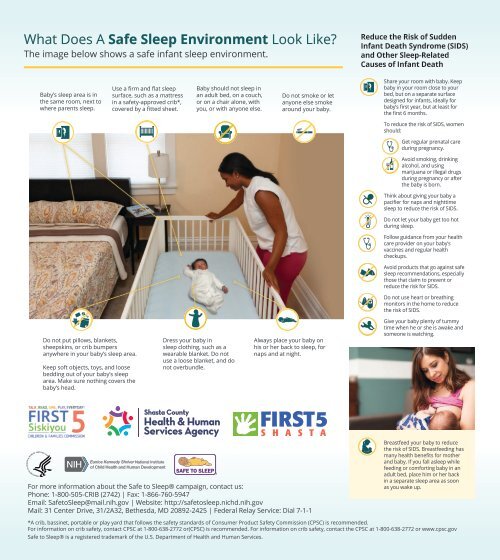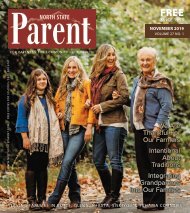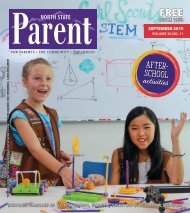GOING PLACES OCTOBER THE EVENTS CALENDAR FOR BUTTE, GLENN, SHASTA, SISKIYOU & TEHAMA COUNTIES Homeschool Sewing Classes; Redding. This sewing series is designed for beginners as well as those who have sewing experience. Beginners will make a pillowcase, apron, pajama pants & backpack. Ages 8-18. Mon/Tue, 1-3pm; thru June 2020. See the 1st. Prenatal Yoga; Redding. Classes are uniquely designed for pregnancy & taught by a certified instructor. All stages of pregnancy are welcome. Mon, 4:30- 5:30pm or Tue/Th, 10:30-11:30am. See the 1st. Preschool Open Gym; Redding. Little ones have a blast with trampolines, foam pits, tumble tracks & much more. Ages 5 & under. Tue/Th, 8:30-9:30am. See the 1st. Sew Much Fun Classes; Redding. This sewing series is designed for beginners as well as those who have sewing experience. Beginners will make a pillowcase, apron, pajama pants & backpack. Ages 8-18. Mon/Tue, 3:30-5:30pm; thru June 2020. See the 1st. SISKIYOU COUNTY Art Mentorship For Kids; Mt. Shasta. Embark on a weekly art adventure to learn the many fundamental skills of art with an award-winning visionary art instructor. Limited to 12 students. Ages 6-12. Tue, 4-6pm; thru June 2020. Free; must pre-reg. Velvet Elephant Art Center, 207 N. Mt. Shasta Blvd. (530)926-2297. Knit & Crochet Tuesday; Dunsmuir. Come join the fun at this weekly needlework event. An experienced instructor is available to help, whether you’re just starting out or are a hook & needles wiz. Open to everyone - supplies available. Free. 1-3pm. Dunsmuir Community Resource Center, 5844 Dunsmuir Ave. (530)235-4400. Beginning Ballroom Dance Classes; Mt. Shasta. Lots of fun for all ages. Tue, 6:45-7:45pm. See the 1st. Martial Arts For All Ages; Mt. Shasta. Dynamic & fun, develops coordination, flexibility, strength, martial arts skills & manners. Ages 3 & up: Mon, 3:30pm ($10 drop-in). Ages 4 & up: Mon-Th, 4:30-5:15pm. Preteens & teens: Tue/Th, 5:30-7pm. Teen & adults: Mon/ Wed, 5:30-7pm. See the 3rd. PAL: Play & Learn Group; Weed. Join an early childhood facilitator with your young child each week to play & learn thru exploration, creativity & sensory play. Ages 5 & under. Tue & Th, 10-11:30am. See the 1st. TEHAMA COUNTY Library Story Time!; Los Molinos. Engaging themebased storytime activities designed to enhance cognitive, language, physical, creative & social-emotional development. Ages 6 & under. Tue, 10am; thru June 2020. Free. Los Molinos Branch Library, 7881 Hwy 99E. (530)527-0607. Kids Fitness Classes; Red Bluff. Group fitness classes taught in a safe & fun environment. Gets kids moving & promotes motor & social skills, cooperative play, athletic development & healthy habits. Ages 4-12. Tue/ Th, 4:20pm. See the 1st. 30|WEDNESDAY BUTTE COUNTY Babies Love Books Storytime; Chico. Enjoy this special storytime. Ages 18mos & under. Wed, 11- 11:30am. Free. Chico Branch Library, 1108 Sherman Ave. (530)891-2726. Bittie Baby & Me: Healthy Newborn; Chico. This class series promotes infant wellness & safety with current info - new topic each week. Make friends in a supportive environment. 10:30am-12pm. $20/class (free if you delivered at Enloe). Enloe Mother & Baby Education Center, 251 Cohasset Rd, Suite 120. (530)332-3970. Cal Bear’s Kid Session; Chico. Young skaters enjoy open skating & instruction. Ages 12 & under. Wed, 10:30am- 12:30pm. $6.25, includes skates (parents skate free). Cal Skate, 2465 Carmichael Dr. (530)343-1601. Chico Wednesday Farmers Market. Enjoy locally grown fruits, vegetables, homemade baked goods, soaps & much more. 7:30am-1pm, year-round, rain or shine. <strong>North</strong> Valley Plaza, Pillsbury Rd. (530)893-3276. Childbirth Preparation Class Series; Chico. Highly trained registered nurse instructors help prepare you for birth, newborn care & breastfeeding in this 5-week series. Promotes individual & family choices, including natural breathing & relaxation techniques & pain management options. Wed, 6-8pm; thru 12/4. $175/ couple. Enloe Mother & Baby Ed. Center, 251 Cohasset Rd. #120. (530)332-3970. Circle Time; Chico. Join the fun with books & stories, songs & rhymes, dancing, shaking, music making & parachute play. All ages. Wed, 3:15-4pm. Free. Apple Blossom Baby, 1372 Longfellow Ave. (530)345-1617. Kids Activity Time; Gridley. Come enjoy a fun activity designed just for kids. Ages 12 & under. Wed, 3pm. Free. Gridley Branch Library, 299 Spruce St. (530)846-3323. Preschool Storytime; Oroville. Preschoolers hear great children’s stories. Ages 3-5. Wed, 11am. Free. Oroville Branch Library, 1820 Mitchell Ave. (530)538-7642. Wildlife Wonders: Bats; Chico. Learn about bats & how they contribute to the world we live in. Get a stamp on your bookmark every time you attend Wildlife Wonders & a cool prize once you fill up your bookmark. All ages. 3-4pm. Free with museum admission, $5-$7. Gateway Science Museum, 625 Esplanade. (530)898-4121. Open Play At Sunny Garden; Chico. Come play with your little one. Ages 5 & under. Tue-Th, 10am-2pm. See the 1st. GLENN COUNTY Crafty Kids; Willows. Children get creative at this fun weekly event with make-&-take crafting activities. Ages 7 & up. Wed, drop in any time between 1-4pm. Free. Willows Public Library, 201 N. Lassen St. (530)934-5156. Storytime; Orland. Children’s storytime with music & a related craft. Ages 3-5. Wed, 11am. Free. Orland Branch Library, 333 Mill St. (530)865-1640. Nurturing Nest Playgroup; Willows. <strong>Parent</strong>s & children enjoy interactive play while building social & emotional skills for future educational experiences & success. Ages 5 & under. Mon & Wed, 9:30-11am. Free. 1035 W. Wood St. (530)934-6882. SHASTA COUNTY Preschool Storytime; Burney. Preschoolers hear great children’s stories & enjoy a craft. Ages 5 & under & their caregivers. Wed, 11am-12pm. Free. Burney Branch Library, 37038 Siskiyou St. (530)335-4317. Read & Play Storytime; Redding. This innovative storytime focuses on sensory practices. Children of all ages welcome, especially those with special needs. Wed, 3:30-4:30pm. Free. Redding Branch Library, 1100 Parkview Ave. (530)245-7250. Viva Momix Theatre; Redding. Artistic director Moses Pendleton combines athletic dance, riveting music, outrageous costumes, inventive props & pure talent to create an entertaining multimedia experience that surprises, enchants & delights. All ages. 7:30pm. $25-$45. Cascade Theatre, 1735 Market St. (530)243-8877. Boomtown BMX Races; Shasta Lake City. All bikes & ages welcome. Wed, 6:30-8:30pm; Fri, 6-7pm or Sun, 6:30-7:30pm; weather permitting. See the 2nd. <strong>Parent</strong> Group: Discipline That Works; Redding. Free parent support group that’s based on the Triple P positive parenting program. Wed, 6-7:30pm. See the 2nd. Wild Horse Viewing; Shingletown. Enjoy viewing & learning more about wild horses & burros. These amazing animals live peaceful & free lives on 5,000 acres in their natural habitat. All ages. Wed & Sat, 10am-4pm. See the 2nd. SISKIYOU COUNTY Children’s Storytime; Dunsmuir. Children of all ages (infants welcome) enjoy stories & a snack. Adult must accompany child. Wed, 3:30-4:30pm. Free. Dunsmuir Branch Library, 5714 Dunsmuir Ave. (530)235-2035. Coffee & Cake; Dunsmuir. Everyone’s invited to get social. Enjoy coffee & cake, chat & find out what the resource center has to offer. Free. Wed, 9:30-11am. Dunsmuir Community Resource Center, 5844 Dunsmuir Ave. (530)235-4400. Make <strong>Parent</strong>ing A Pleasure; Yreka. In this 12-week evidence-based parenting class, you will get ideas to support your child’s development, deal with discipline challenges & learn more about communication, selfcare, stress, & anger management. Dinner & childcare provided. For parents of ages 8 & under. Wed, 5:30- 7:30pm; thru 12/11. Free; must pre-reg. Yreka Community Resource Center, 201 S. Broadway. (530)842-1313. Preschool Storytellers; Yreka. Hear a different storyteller read, sing songs & make crafts each week. All ages. Wed, 10-11am. Free. Yreka Library, 719 4th St. (530)841-4175. Songs & Stories; Mt. Shasta. Children ages 5 & under enjoy fun stories & sing along to music. An adult must accompany young children. Wed, 10:30am. Free. Mt. Shasta Branch Library, 515 E. Alma St. (530)926-2031. Ballroom Dance Classes: Beginning/Intermediate; Mt. Shasta. Learn the smooth & quickstep dances & how to lead or follow. Wed, 6:45-7:45pm. See the 2nd. Martial Arts For All Ages; Mt. Shasta. Dynamic & fun, develops coordination, flexibility, strength, martial arts skills & manners. Ages 3 & up: Mon, 3:30pm ($10 drop-in). Ages 4 & up: Mon-Th, 4:30-5:15pm. Preteens & teens: Tue/Th, 5:30-7pm. Teen & adults: Mon/ Wed, 5:30-7pm. See the 2nd. TEHAMA COUNTY Library Story Time!; Red Bluff. Engaging theme-based storytime activities designed to enhance cognitive skills, language, physical, creative & social-emotional development. Ages 6 & under. Wed, 10am; thru June 2020. Free. Red Bluff Branch Library, 545 Diamond Ave. (530)527-0607. 31|THURSDAY HALLOWEEN BUTTE COUNTY Circle Time; Chico. Join the fun with books & stories, songs & rhymes, dancing, shaking, music making & parachute play. All ages. Tue/Th, 9:15-10am. Free. Apple Blossom Baby, 1372 Longfellow Ave. (530)345-1617. Play Chess; Chico. Learn to play chess with teen volunteers. All ages. Th, 3:30-5:30pm & Sat, 11am- 1pm. Free. Chico Branch Library, 1108 Sherman Ave. (530)891-2726. Preschool Storytime; Durham. Stories, songs & activities for children & parents/caregivers. Ages 5 & under. Th, 10am. Free. Durham Branch Library, 2545 Durham Dayton Hwy. (530)879-3835. Rhythm Kids; Chico. Young children enjoy music on the drums, play & more. Ages 5-7. Th, 2:15pm. $8/ class. Sunny Garden Montessori, 2801 Godman Ave., Ste. 140. (530)343-3101. Safe & Sane Trick Or Treat; Chico. Enjoy this annual event by Chico Mall which begins at 4pm & ends when the candy runs out. Participating stores only. Ages 12 & under. 4pm. Free. Chico Mall, 1950 E. 20th St. Ste., 727. (530)343-0706. Toddler Storytime; Chico. Stories, songs & action rhymes. Ages 3 & under. Th, 10am & 11am. Free. Chico Branch Library, 1108 Sherman Ave. (530)891-2726. Butte Homeschoolers Park Day; Chico. All homeschoolers welcome. Th, 1-4pm. Free. See the 5th. Cheernastics Class; Chico. Get extra practice on cheerleading skills or prepare to be an All Star. Tue/Th 3:30-5pm. See the 1st. Open Play At Sunny Garden; Chico. Come play with your little one. Ages 5 & under. Tue-Th, 10am-2pm. See the 1st. Sign Language For Toddlers; Chico. Young children learn sign language & socialize during a circle time that includes a welcome song, reading books, singing songs, art activities, parachute play & more. Ages 5 & under. Th, 1pm. See the 3rd. Silver Dollar BMX Racing; Chico. Enjoy the fun. Practices Tue (5:30pm); Racing on Th (7pm) & Sun (11am). All ages. See the 1st. GLENN COUNTY Babies & Books; Orland. Babies & parents enjoy storytime together. Ages 2.5 & under. Th, 11am. Free. Orland Branch Library, 333 Mill St. (530)865-1640. SHASTA COUNTY Historic Hawes Farms; Anderson. Save money & miss the crowds at family fun nights. Find a pumpkin & ride the rides. Eat, drink & be merry. All ages. Th & Fri. 5-8pm; thru 10/27. $10.95+. 6465 Deschutes Rd. (530)365-8488. Little Explorers: Nighttime Wonders; Redding. What animals come out only at night? Come & find out what they are doing when you are sound asleep. For ages 2-5 & their caregivers. Th, 10-11am. Free for members or with park admission, $12.50-$16.50; ages 3 & under free. Turtle Bay Exploration Park Mill Building, 844 Sundial Bridge Dr. (530)243-8850. Palo Cedro Farmers Market & Craft Fair. This certified farmers market features several varieties of freshly harvested micro greens & more. The crafts section has vendors with candles, lotions, jewelry, soap, crocheted & hand-sewn goodies. All ages. Th, 3-6pm; year-round. Free. Palo Cedro Guild, 22307 Old 44 Dr. (530)547-3788. PlayGym; Redding. This class helps little ones grow & thrive by promoting motor, mental & social development thru gymnastics, song, dance & play. Ages 3-5. Th, 10:15-11am. $7/class (Y members $5/class). Shasta Family YMCA, 1155 N. Court St. (530)246-9622. Raising A Reader Read-To-Me Book Club; Redding. Children enjoy a weekly storytime with matching activities. Stories center around a monthly theme; includes a book bag to take home each month to encourage family reading time. Ages 2-5. Th, 9-10am; thru 12/5. $5/class (Y members $3). Shasta Family YMCA, 1155 N. Court St. (530)246-9622. Read & Create Storytime; Redding. Focusing on art themes, this storytime welcomes children of all ages. Th, 3:30-4:30pm. Free. Redding Branch Library, 1100 Parkview Ave. (530)245-7250. Rockin’ Reptiles; Redding. Come meet some of Turtle Bay’s scaly or slithering ambassadors in this up close encounter, with different animals presented each week. All ages. Th, 2pm; thru 11/30. Free for members or with park admission, $12.50-$16.50. Turtle Bay Exploration Park Mill Building, 844 Sundial Bridge Dr. (530)243-8850. Storytime; Anderson. Just in time for Halloween. Celebrate pumpkins with pumpkin stories, crafts, stickers & more. Each child receives a small bag with healthy treats. Ages 5 & under. Th, 3:30pm. Free. Anderson Branch Library, 3200 W. Center St. (530)365-7685. Homeschool PE; Redding. Children in grades K thru 8 build physical fitness & enhance skill development with age-appropriate activities. Free with Y membership. Tue & Th, 3-4pm. See the 1st. Kidfit Classes; Redding. Kids ages 5-10 have a great time moving & playing while increasing flexibility, balance & motor skills. Mon/Th, 4-4:45pm. See the 3rd. Prenatal Yoga; Redding. Classes are uniquely designed for pregnancy & taught by a certified instructor. All stages of pregnancy are welcome. Mon, 4:30- 5:30pm or Tue/Th, 10:30-11:30am. See the 1st. Preschool Open Gym; Redding. Little ones have a blast with trampolines, foam pits, tumble tracks & much more. Ages 5 & under. Tue/Th, 8:30-9:30am. See the 1st. Storytime. Celebrate the joys of reading at this weekly storytime in the waiting room. For ages 5 & under. Th, 3:30pm. See the 3rd. SISKIYOU COUNTY Climbing Gym; Mt. Shasta. Get ready for indoor exercise & fun as you climb the walls. All ages; 14 & under need parental supervision. Th-Sun, 10am-5pm. See the 3rd. Intermediate/Advanced Ballroom Dance Classes; Mt. Shasta. Fun, supportive environment develops technique & skills at the intermediate level. Solo dancers welcome. Th, 6:45-7:45pm. See the 3rd. Martial Arts For All Ages; Mt. Shasta. Dynamic & fun, develops coordination, flexibility, strength, martial arts skills & manners. Ages 3 & up: Mon, 3:30pm ($10 drop-in). Ages 4 & up: Mon-Th, 4:30-5:15pm. Preteens & teens: Tue/Th, 5:30-7pm. Teen & adults: Mon/ Wed, 5:30-7pm. See the 2nd. PAL: Play & Learn Group; Dunsmuir. Join an early childhood facilitator with your young child each week to play & learn thru exploration, creativity & sensory play. Ages 5 & under. Th, 10:30am-12pm. See the 3rd. PAL: Play & Learn Group; Weed. Join an early childhood facilitator with your young child each week to play & learn thru exploration, creativity & sensory play. Ages 5 & under. Tue & Th, 10-11:30am. See the 1st. TEHAMA COUNTY Kids Fitness Classes; Red Bluff. Group fitness classes taught in a safe & fun environment. Gets kids moving & promotes motor & social skills, cooperative play, athletic development & healthy habits. Ages 4-12. Tue/ Th, 4:20pm. See the 1st. 54 <strong>North</strong> <strong>State</strong> <strong>Parent</strong> • Serving Upper California Since 1993
What Does A Safe Sleep Environment Look Like? The image below shows a safe infant sleep environment. Reduce the Risk of Sudden Infant Death Syndrome (SIDS) and Other Sleep-Related Causes of Infant Death Baby’s sleep area is in the same room, next to where parents sleep. Use a firm and flat sleep surface, such as a mattress in a safety-approved crib*, covered by a fitted sheet. Baby should not sleep in an adult bed, on a couch, or on a chair alone, with you, or with anyone else. Do not smoke or let anyone else smoke around your baby. Share your room with baby. Keep baby in your room close to your bed, but on a separate surface designed for infants, ideally for baby’s first year, but at least for the first 6 months. To reduce the risk of SIDS, women should: Get regular prenatal care during pregnancy. Avoid smoking, drinking alcohol, and using marijuana or illegal drugs during pregnancy or after the baby is born. Think about giving your baby a pacifier for naps and nighttime sleep to reduce the risk of SIDS. Do not let your baby get too hot during sleep. Follow guidance from your health care provider on your baby’s vaccines and regular health checkups. Avoid products that go against safe sleep recommendations, especially those that claim to prevent or reduce the risk for SIDS. Do not use heart or breathing monitors in the home to reduce the risk of SIDS. Do not put pillows, blankets, sheepskins, or crib bumpers anywhere in your baby’s sleep area. Keep soft objects, toys, and loose bedding out of your baby’s sleep area. Make sure nothing covers the baby’s head. Dress your baby in sleep clothing, such as a wearable blanket. Do not use a loose blanket, and do not overbundle. Always place your baby on his or her back to sleep, for naps and at night. Give your baby plenty of tummy time when he or she is awake and someone is watching. For more information about the Safe to Sleep® campaign, contact us: Phone: 1-800-505-CRIB (2742) | Fax: 1-866-760-5947 Email: SafetoSleep@mail.nih.gov | Website: http://safetosleep.nichd.nih.gov Mail: 31 Center Drive, 31/2A32, Bethesda, MD 20892-2425 | Federal Relay Service: Dial 7-1-1 Breastfeed your baby to reduce the risk of SIDS. Breastfeeding has many health benefits for mother and baby. If you fall asleep while feeding or comforting baby in an adult bed, place him or her back in a separate sleep area as soon as you wake up. *A crib, bassinet, portable or play yard that follows the safety standards of Consumer Product Safety Commission (CPSC) is recommended. For information on crib safety, contact CPSC at 1-800-638-2772 or(CPSC) is recommended. For information on crib safety, contact the CPSC at 1-800-638-2772 or www.cpsc.gov Safe to Sleep® is a registered trademark of the U.S. Department of Health and Human Services.




